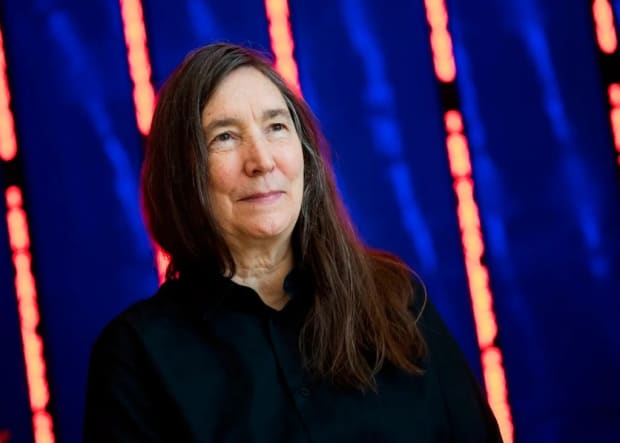-
Overview
I used language because I wanted to offer content that people - not necessarily art people - could understand.
Jenny Holzer, born on July 29, 1950, in Gallipolis, Ohio, is an esteemed American conceptual and installation artist whose groundbreaking use of text in public spaces has left an indelible mark on the art world. Holzer’s innovative approach spans various media, including electronic signs, carved stone, paintings, billboards, and printed materials, each serving as a platform for her thought-provoking messages.
Holzer’s educational journey laid the foundation for her unique artistic vision. She studied at Duke University, the University of Chicago, and Ohio University, where she earned a BFA. Further refining her craft, she participated in the Whitney Museum Independent Study Program. This diverse educational background influenced her multidisciplinary approach to art.
Holzer first garnered attention in the late 1970s with her "Truisms" series, a collection of aphoristic statements anonymously posted throughout New York City. This project established her signature style, using language to challenge perceptions and incite public discourse. Her texts, often direct and confrontational, address themes such as social justice, power dynamics, violence, and human vulnerability.
Throughout her career, Holzer has continually pushed the boundaries of conceptual art. Her iconic LED installations utilize scrolling texts to engage audiences in both intimate and expansive public spaces. In addition to electronic media, Holzer’s stone carvings and permanent installations merge textual art with sculptural form, creating enduring pieces that provoke reflection and dialogue.
Holzer’s work is distinguished by the tension she creates between emotion and intellect. Her texts juxtapose stark, factual language with deeply emotional content, exploring the complexities of human experience. This interplay underscores her commentary on both individual and collective realities, examining issues of power, violence, vulnerability, and tenderness.
Holzer’s contributions to art and public discourse have been widely recognized. She received the prestigious Golden Lion at the Venice Biennale in 1990, highlighting her influence and impact. Her works have been exhibited in major institutions such as the Guggenheim Museum, the Museum of Modern Art, and the Whitney Museum of American Art, and are part of prominent collections worldwide.
In addition to her exhibitions, Holzer’s projects often inhabit public spaces, reaching diverse audiences and fostering broader engagement with her work. Her large-scale projections on urban architecture and intimate installations in natural settings demonstrate her commitment to making art accessible and relevant to the public.
Jenny Holzer’s practice transcends conventional artistic boundaries, utilizing language as a powerful tool for social and political commentary. Her work continues to resonate deeply, challenging viewers to consider the complexities of power, justice, and human experience in contemporary society. Holzer’s remarkable career reflects her dedication to provoking thought and inspiring change through art.
-
New In Jenny Holzer Installation Art
-

-
Series

Jenny Holzer
Non Lo Sopporto, 2001C-print photograph
16 × 20 in
40.6 × 50.8 cm
Edition of 10Series: ProjectionsCopyright The ArtistJenny Holzer’s projections are one of her most compelling and innovative forms of art, designed to engage the public directly by utilizing urban and natural environments as canvases for her...Jenny Holzer’s projections are one of her most compelling and innovative forms of art, designed to engage the public directly by utilizing urban and natural environments as canvases for her messages. These works involve projecting text onto various surfaces, such as buildings, landscapes, and water, transforming public spaces into platforms for thought-provoking dialogue on social and political issues. The projections often feature texts that include her own writing, declassified government documents, poetry, and quotes from various authors.
Holzer uses advanced technology to create her projections, employing high-powered projectors to cast text onto large surfaces with clarity and precision. Each projection is site-specific, carefully planned to suit the architectural and cultural context of the location. This meticulous approach ensures that the text interacts meaningfully with its environment, adding layers of significance to the work. By choosing prominent and accessible locations, Holzer maximizes public engagement and democratizes art, making it an integral part of everyday life.
Some of Holzer’s notable projection projects include "Innoculation" in Venice, where she projected texts onto historic buildings and canal waters, addressing themes of memory and history. In New York City, she projected poems onto the Rockefeller Center and declassified documents onto building facades, inviting the public to scrutinize and question authority. In the United Kingdom, her projections on landmarks like the Tate Modern and Edinburgh Castle tackled issues of war, conflict, and human rights, resonating deeply with diverse audiences.
The themes and messages in Holzer’s projections often focus on political commentary, exploring issues such as war, censorship, and governmental transparency. By using declassified documents and controversial statements, she invites the public to engage critically with authority and consider the complexities of power dynamics. Her texts also evoke strong emotional responses by blending personal reflections with broader social commentary, creating a powerful connection between the viewer and the message.
Holzer’s projections have been widely praised for their innovation and impact, becoming a defining feature of her oeuvre. They exemplify her commitment to using art as a medium for social and political engagement, transforming public spaces into arenas for thought and discourse. Through these works, she continues to challenge viewers to confront uncomfortable truths and consider the complexities of contemporary life, making her art relevant and influential in the ongoing dialogue about societal issues.
News






